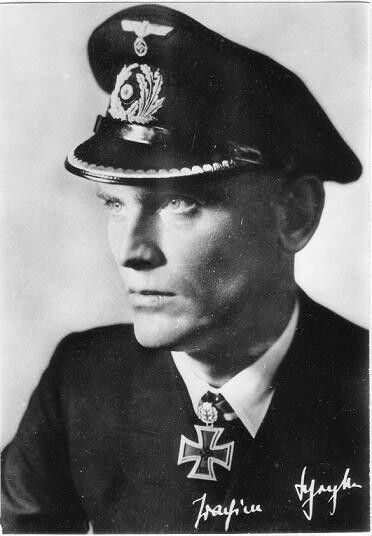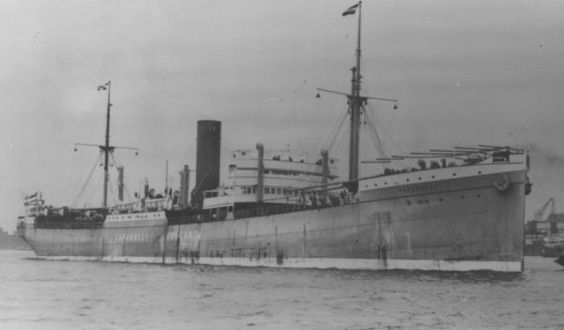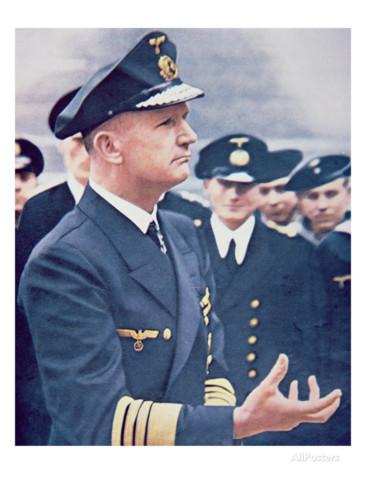Monday 17 March 1941
 |
| The Marit Maersk arrives at Piræus, Greece, on 17 March 1941. |
The British reinforcement of Greece, Operation Lustre, continues. The New Zealand 4th Infantry Brigade arrives at Athens today from Alexandria.
East African Campaign: The Italian counterattacks at Keren continue today. The British still occupy Fort Dologorodoc and the Pinnacle and Pimple formations to the right of the Dongolaas Gorge, but further advances are becoming difficult. The British 29th Brigade does capture Falestoh and Zeban near the fort, but bringing supplies over the exposed rock, with the Italians in the heights above raining fire down on everyone making the trip, proves too difficult. After dark today, the advanced British troops abandon Falestoh and Zeban. The Italians also launch rabid counterattacks against Fort Dologorodoc which the 5th Indian Division has difficulty fighting off.
On the left side of the gorge, things are even less satisfactory for the British. The 4th Indian Division has been attacking the Sanchil heights without progress. Finally, after dark tonight when the lack of light makes crossing the open areas less dangerous, the Indian troops retreat to their original jump-off positions. The Indian troops retain a few new areas, such as Hog's Back and Flat Top, but the Italian troops are counterattacking everywhere. The fighting is desperate and savage, often descending into hand-to-hand fighting with knives and whatever else is handy.
In central Abyssinia, Lt. General Cunningham's 23rd Nigerian Brigade of the British 1st African Division troops finally capture Jijiga after a long struggle. They only are able to do this because the strong Italian defensive forces in the town have abandoned it. The British troops now have advanced 1000 miles from Kenya, but Abyssinia still remains unsubdued. Jijiga is to become a British base until after the war.
European Air Operations: The Luftwaffe bombs Bristol again, continuing its pattern of hitting the same medium-sized city multiple times in a row. Tonight, 162 planes hit the Avonmouth district. RAF Bomber Command sends 58 bombers against Bremen and 21 against Wilhelmshaven, where they can waste their bombs against perpetual target Tirpitz.
 |
| Kapitänleutnant Joachim Schepke (8 March 1912 – 17 March 1941). |
 |
| Otto Kretschmer. |
CAPTAIN TO CAPTAIN. I AM SUNKING [sic] PLEASE RESCUE MY CREW.Forty crew manage to escape and become POWs, including Kretschmer, while three crew (including the engineering officer who re-entered the sinking sub to scuttle it) perish. Captain Macintyre of the Walker takes credit for the sinking.
That is only the beginning of the Germans' bad night.
U-100 (Kptlt. Joachim Schepke) also has been drawn to Convoy by U-boat command (BdU). Captain Schepke approaches HX-112 from behind. Having to make up ground, he is on the surface by necessity, not a choice as in the case with Kretschmer. HMS Vanoc detects U-100 from about 1000 meters/yards with its Type 286 radar. This is the first such interception of a U-boat using radar - not a first that Schepke would want to be any part of. Vanoc hurries over as Schepke dives and manages to ram the U-boat before it can reach a safe depth. Schepke perishes along with 47 of his mates, while six men survive.
Schepke's and Kretschmer's losses to the U-boat fleet, along with Guenther Prien's loss ten days ago, are devastating to the U-boat fleet. The German military is based on stars and supporting players - there are "experten" and everyone else. In other words, the quality of the services depends upon a broad but very thin layer of aces who excel far beyond others. Prien, Schepke, and Kretschmer are impossible to replace, not because the U-boat doesn't have other good captains - it does - but all three have that "something special" that can't be taught. Kretschmer, in particular, has been like a quarterback on a good football team, directing other U-boats in attacks even when his boat is out of torpedoes and simply observing. Some put today as the end of the first U-boat "Happy Time," when the going is good and U-boat losses are low.
 |
| Dutch freighter Tapanoeli, sunk today by U-106. |
Oesten also attacks two other ships but misses.
- 3082 ton British freighter Andalusian (all rescued)
- 7034 ton Dutch freighter Tapanoeli (all rescued)
Having just completed perhaps the most complete convoy destruction to date on 15-16 March, Gneisenau and Scharnhorst head away from the scene of devastation. Admiral Lütjens plans to rendezvous with supply ships Uckermark and Ermland, then head for port Brest in France. The Royal Navy has Force H out of Gibraltar at sea looking for them.
Having obtained its seaplanes and stocked up with supplies at Kiel, the German battleship Bismarck departs from Kiel and makes port at Gdynia (Gotenhafen) today.
German raider Kormoran and U-124 now have sailed far enough southwest (1150 miles southwest of the Cape Verde Islands) to find somewhat calmer waters and affect their supply transfer with cruiser Admiral Scheer. U-124 has brought radar parts for the German cruiser, but the seas remain too rough for Kormoran to transfer its eight torpedoes to the U-boat.
The Luftwaffe bombs and sinks Royal Navy 597-ton anti-submarine yacht HMY Mollusc a few kilometers from Blyth Port War Signal Station. Everyone survives.
The Luftwaffe bombs and damages 2848-ton British freighter Cormead off Southwold and 281-ton British pilot cutter Pioneer in the Thames Estuary.
Norwegian 1858-ton freighter Einar Jarl hits a mine and sinks in the North Sea off Wormiston, Scotland. There is one death.
The Royal Navy's 1st Minelaying Squadron sets out from Loch Alsh to lay minefield SN 69. Minelayer Teviotbank, back in service after being damaged by the Luftwaffe, lays minefield BS 51 off the English East Coast.
Convoy OG 56 departs from Liverpool, Convoy HX 115 departs from Halifax.
Royal Navy corvette HMS Dianthus (K 95, Lt. Commander Clement E. Bridgman) is commissioned, corvette HMCS Kamloops (K 176, Lt. James M. Gillison) is commissioned, and destroyer KNM Arendal (Hunt-class destroyer HMS Badsworth) and minesweeping trawler Orfsay are launched.
U-218 is laid down.
 |
| KNM Arendal (HMS Badsworth). |
The RAF (Swordfish of Squadron No. 815) torpedo and sink Italian torpedo boat Andromeda in the Adriatic off Valona (Vlorë), Albania.
The Regia Aeronautica attacks Benghazi.
Convoy AG 6A departs from Alexandria bound for Piraeus, Convoy BN 20 departs from Aden bound for Suez.
Battle of the Indian Ocean: German raider Pinguin continues its replenishment operations in the Kerguelen Islands alongside supply ship Adjutant. The ship takes water from a waterfall to replenish its water tanks.
Convoy BM 5 departs from Bombay.
US/Australian Relations: With the visit to Australia by Rear Admiral John H. Newton, Commander Cruisers Scouting Force, approved for 20 March, the US sends a small detachment ahead to New Zealand. Captain Ellis S. Stone leads TG 9.2 to Auckland. They will remain there until Newton's main force makes the journey toward Sydney, at which point TG 9.2 will head to Tahiti.
German/Turkish Relations: Hitler meets with the Turkish ambassador. The Turks want nothing to do with this war, on either side, despite offers of all kinds of inducements.
British Military: Air Vice-Marshal Richard Saul, Air Officer Commanding No. 12 Group (the successor to Trafford Leigh-Mallory) is made Companion of the Order of the Bath.
Greenland: The United States South Greenland Survey Expedition leaves Boston, Massachusetts today aboard US Coast Guard cutter USCGC Cayuga. The objective is to map Greenland for sites for things like airstrips and meteorological stations. Having declared itself a self-governing territory in 1940, Greenland currently is under United States protection.
Channel Islands: The occupation of the Channel Islands by the Germans has been, for the most part, a smooth affair. However, the island is indeed occupied and the Germans are authorized to apply harsh punishments in the Channel Islands just like anywhere else. Today, Frenchman Francois Scornet, 22, of Brittany is executed in Jersey. Scornet is a French Army Cadet who fled to the Channel Islands upon the Fall of France. In fact, he had intended to reach England but got lost in a storm. Scornet, who the Germans describe as the "ringleader" of a group of 16 such refugees, is shot as a symbolic act, as a way to "send a message" to others thinking of fleeing German occupation. Scornet will be the only civilian executed by firing squad in Jersey during the war.
China: The Japanese attack the Chinese lines in the Battle of Shanggao in the direction of Haulintsai and Shangfutsun. The Chinese are well dug-in, though, and the Japanese take heavy casualties. The day ends with the lines little changed, but many dead and dying on both sides.
Prime Minister Robert Menzies, in England for a few months, visits the Rolls Royce plant at Derby. He notes that there are "Many women employed on hard work. Music half an hour morning & afternoon. Everyone likes it 'except a few old fogies.'"
German Homefront: The German government maintains close tabs on trends in public sentiment as reflected in things like currently popular jokes and commodities. The reports now indicate that foreign-language prophecies are popular in churches that describe this as the time in Germany of a "dreadful warrior" who will be called the "Antichrist." As is often the case with these reports, the meaning of the jibe is open to interpretation - the fact that other nations call the German leader names may mean he is threatening them while helping Germany. On the other hand, taken literally, the suddenly popular prophecy may mean that people everywhere - and including Germany - are starting to view Hitler extremely negatively. Overall, it does not seem like a positive thing for the government that words like "Antichrist" are being thrown around about Germany's leader.
American Homefront: President Roosevelt dedicates the National Gallery of Art in Washington, D.C.
Future History: Paul Lorin Kantner is born in San Francisco, California. As a teenager, Kantner becomes a protest folk singer. He drops out of school and begins performing full time. In 1965, he meets Marty Balin, and together they form a band called Jefferson Airplane. Kantner writes many of the band's songs as well as playing rhythm guitar and singing. Jefferson Airplane has many hits in the '60s and is the main attraction at festivals at Monterey, Altamont, and Woodstock. He begins collaborating in more ways than one with fellow bandmate Grace Slick, and together have daughter China Wing Kantner in 1971. The band continues into the 1980s, at which it has the first of many name changes, to Jefferson Starship. Kantner, the last founding member of Jefferson still left with the band, leaves in 1984, forcing the name change. Kantner and his Jefferson Airplane bandmates are inducted into the Rock and Roll Hall of Fame in 1996. Paul Kantner passed away on 28 January 2016.
March 1941
March 1, 1941: Rettungsboje
March 2, 1941: Oath of Kufra
March 3, 1941: Germans in Bulgaria
March 4, 1941: Lofoten Islands Raid
March 5, 1941: Cooperation With Japan
March 6, 1941: Battle of Atlantic
March 7, 1941: Prien Goes Under
March 8, 1941: Cafe de Paris
March 9, 1941: Italian Spring Offensive
March 10, 1941: Humanitarian Aid
March 11, 1941: Lend Lease Become Law
March 12, 1941: A New Magna Carta
March 13, 1941: Clydeside Wrecked
March 14, 1941: Leeds Blitz
March 15, 1941: Cruisers Strike!
March 16, 1941: Kretschmer Attacks
March 17, 1941: Happy Time Ends
March 18, 1941: Woolton Pie
March 19, 1941: London Hit Hard
March 20, 1941: Romeo and Juliet
March 21, 1941: Plymouth Blitz
March 22, 1941: Grand Coulee Dam
March 23, 1941: Malta Under Siege
March 24, 1941: Afrika Korps Strikes!
March 25, 1941: Yugoslavia Joins The Party
March 26, 1941: Barchini Esplosivi
March 27, 1941: Belgrade Coup
March 28, 1941: Cape Matapan Battle
March 29, 1941: Lindbergh Rants
March 30, 1941: Commissar Order
March 31, 1941: Cookie Bombs
2020



No comments:
Post a Comment